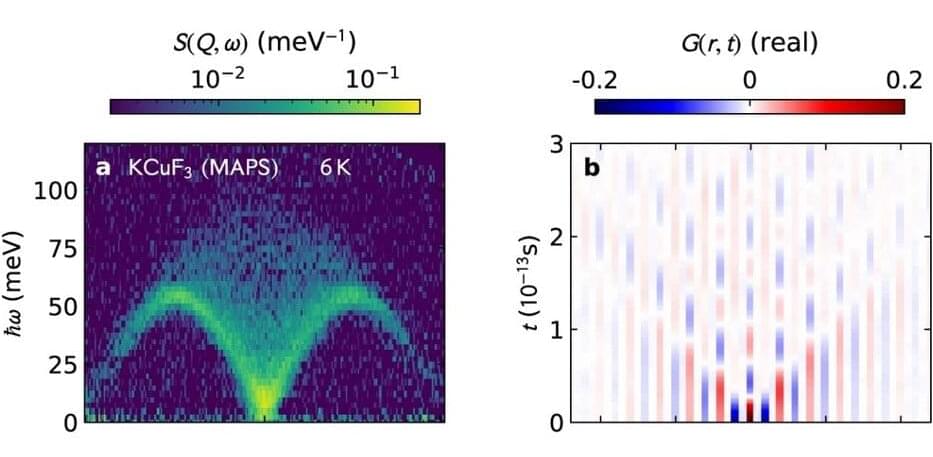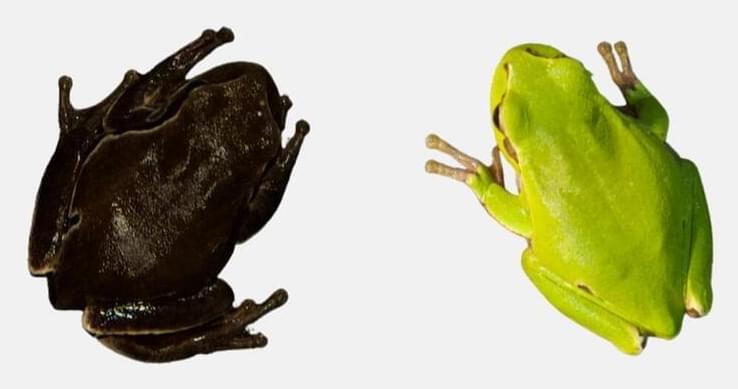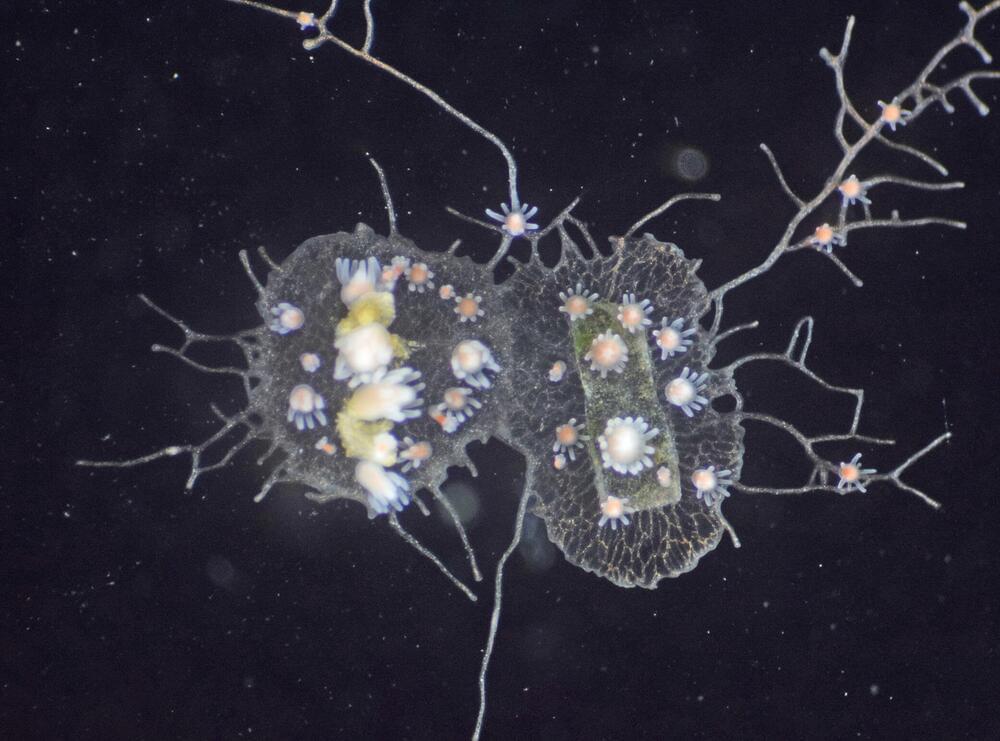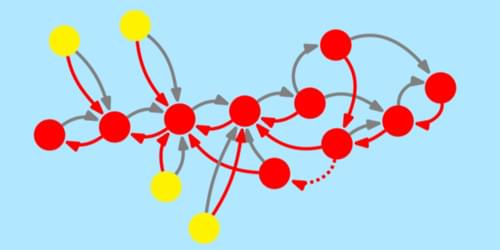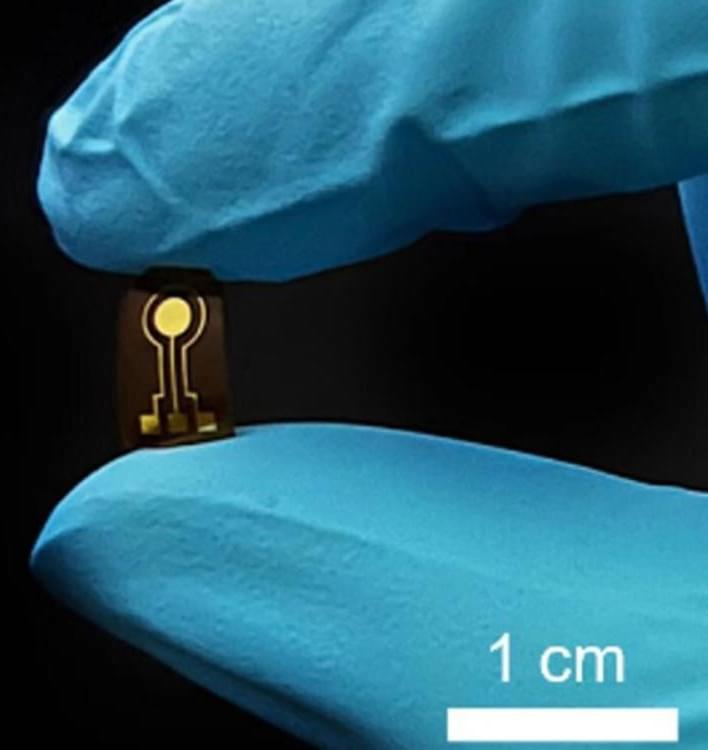Archive for the ‘evolution’ category: Page 63
Oct 4, 2022
Dynamics in one-dimensional spin chains: A new toolbox for elucidating future quantum materials
Posted by Saúl Morales Rodriguéz in categories: evolution, quantum physics
Neutron scattering is considered the method of choice for investigating magnetic structures and excitations in quantum materials. Now, for the first time, the evaluation of measurement data from the 2000s with new methods has provided much deeper insights into a model system—the 1D Heisenberg spin chains. A new toolbox for elucidating future quantum materials has been achieved.
Potassium copper fluoride (KCuF3 ) is considered the simplest model material for realizing the so-called Heisenberg quantum spin chain: The spins interact with their neighbors antiferromagnetically along a single direction (one-dimensional), governed by the laws of quantum physics.
“We carried out the measurements on this simple model material at the ISIS spallation neutron source some time ago when I was a postdoc, and we published our results in 2005, 2013 and again in 2021, comparing to new theories each time they became available,” says Prof. Bella Lake, who heads the HZB-Institute Quantum Phenomena in Novel Materials. Now with new and extended methods, a team led by Prof. Alan Tennant and Dr. Allen Scheie has succeeded in gaining significantly deeper insights into the interactions between the spins and their spatial and temporal evolution.
Sep 30, 2022
Chernobyl black frogs reveal evolution in action
Posted by Genevieve Klien in categories: biological, evolution, genetics, nuclear energy
The accident at reactor four of the Chernobyl Nuclear Power Plant in 1986 generated the largest release of radioactive material into the environment in human history. The impact of the acute exposure to high doses of radiation was severe for the environment and the human population. But more than three decades after the accident, Chernobyl has become one of the largest nature reserves in Europe. A diverse range of endangered species finds refuge there today, including bears, wolves, and lynxes.
Radiation can damage the genetic material of living organisms and generate undesirable mutations. However, one of the most interesting research topics in Chernobyl is trying to detect if some species are actually adapting to live with radiation. As with other pollutants, radiation could be a very strong selective factor, favoring organisms with mechanisms that increase their survival in areas contaminated with radioactive substances.
Sep 29, 2022
Going Beyond Fermi’s Golden Rule
Posted by Saúl Morales Rodriguéz in categories: evolution, particle physics, quantum physics
Researchers have calculated the likelihood that a quantum state will decay when its evolution is inhibited by a dearth of final states.
Quantum systems are fragile, meaning a specific quantum state generally decays into other states over time. This decay process is formalized by Fermi’s golden rule (FGR), which in its traditional formalization applies when there exists an infinite continuum of states for the quantum system state to decay to—for example, when an excited atom emits a photon into a vacuum. Now Tobias Micklitz at the Brazilian Center for Research in Physics and colleagues have developed and solved a model showing how a quantum system evolves when its initial state is instead coupled to a finite set of states spread across discrete energy levels [1]. Micklitz says that their model could be the foundation for models of more complex, many-body quantum systems.
FGR-obeying systems occupy one end of a scale, where the coupling strength between the systems’ initial and final states is large relative to the energy gap between the various final states (zero for a continuum of states). At the other end of the scale, the coupling strength is much lower relative to this gap. A system that sits in this second regime remains in its initial state, as there are too few available final states for it to decay into.
Sep 27, 2022
Tiny sea creature’s genes shed light on evolution of immunity
Posted by Dan Breeden in categories: biotech/medical, evolution
How a tiny marine invertebrate distinguishes its own cells from competitors’ bears striking similarities to the human immune system, according to a new study led by University of Pittsburgh School of Medicine researchers.
The findings, published now in Proceedings of the National Academy of Sciences, suggest that the building blocks of our immune system evolved much earlier than previously thought and could help improve understanding of transplant rejection, one day guiding development of new immunotherapies.
“For decades, researchers have wondered whether self-recognition in a marine creature called Hydractinia symbiolongicarpus was akin to the processes that control whether a piece of skin can be successfully grafted from one person to another,” said senior author Matthew Nictora, Ph.D., assistant professor of surgery and immunology at the Thomas E. Starzl Transplantation Institute. “Our study shows for the first time that a special group of proteins called the immunoglobulin superfamily— which are important for adaptive immunity in mammals and other vertebrates—are found in such a distantly-related animal.”
Sep 24, 2022
3001 The Final Odyssey- Prologue
Posted by Dan Breeden in categories: alien life, evolution

Call them the Firstborn. Though they were not remotely human, they were flesh and blood, and when they looked out across the deeps of space, they felt awe, and wonder— and loneliness. As soon as they possessed the power, they began to seek for fellowship among the stars.
In their explorations, they encountered life in many forms, and watched the workings of evolution on a thousand worlds. They saw how often the first faint sparks of intelligence flickered and died in the cosmic night.
Sep 23, 2022
Scientists Use CRISPR to Condense a Million Years of Evolution Into Mere Months
Posted by Shubham Ghosh Roy in categories: bioengineering, biotech/medical, evolution, genetics
Chromosome-level engineering is a completely different beast: it’s like rearranging multiple paragraphs or shifting complete sections of an article and simultaneously hoping the changes add capabilities that can be passed onto the next generation.
Reprogramming life isn’t easy. Xiao Zhu’s DNA makeup is built from genetic letters already optimized by eons of evolutionary pressure. It’s no surprise that tinkering with an established genomic book often results in life that’s not viable. So far, only yeast have survived the rejiggering of their chromosomes.
The new study, published in Science, made the technology possible for mice. The team artificially fused together chunks from mice chromosomes. One fused pair made from chromosomes four and five was able to support embryos that developed into healthy—if somewhat strangely behaved—mice. Remarkably, even with this tectonic shift to their normal genetics, the mice could reproduce and pass on their engineered genetic quirks to a second generation of offspring.
Sep 22, 2022
Disordered Systems Mimic Genetic Evolution
Posted by Saúl Morales Rodriguéz in categories: biotech/medical, evolution, genetics
Modern medicine forces bacteria to adapt: in response to antibiotic treatment, they either increase their fitness or die out. Whether a bacterial population survives or not depends on a combination of its genetics and environment—the antibiotic concentration—at a given moment. Now Suman Das of the University of Cologne, Germany, and colleagues simulate the effect on adaptation of an environment that is constantly changing [1]. Using a model that describes how slow-moving disordered systems respond to external forces, the researchers find that microbe evolution in changing drug concentrations exhibits hysteresis and memory formation. They use analytical methods and numerical simulations to connect these statistical physics concepts to bacterial drug resistance.
The team’s model examines changes in a bacterial population’s genetic sequences. By combining data on bacterial growth rates with statistical tools, the researchers describe how the bacterial genome can store information about both present and past drug concentrations. Their simulations start with a genetic sequence optimized for a certain antibiotic concentration. They then track how the sequence mutates when the concentration shifts to another value. When the concentration increases and then reduces to a lower value, the genetic route taken on the downward path depends on the changes on the upward path. How different the mutation routes are depends on the rate of concentration change.
The researchers find that this behavior mimics that of disordered systems driven by external forces, such as ferromagnetic materials subjected to magnetic fields or amorphous materials subjected to a shearing force. They say that while their approach focuses on the evolution of drug resistance, the framework can be adapted to other problems in evolutionary biology that involve changing environmental parameters.
Sep 20, 2022
Scientists have found a mineral stronger than diamond
Posted by Kelvin Dafiaghor in categories: evolution, space
They say lonsdaleite could be used to fortify industrial tools like drill bits and saw blades — AND teach us about the evolution of earth.
AYESHA RASCOE, HOST:
Move over, diamonds. There’s stronger bling in town. Meet lonsdaleite — for years just a theory. Now CNN reports that scientists have confirmed its existence on Earth. While diamonds and lonsdaleite are both made of carbon — get ready for this — the former has a cubic atomic structure, and the latter has a hexagonal structure. So what’s the big difference? That hexagonal structure makes the stone 58% stronger than regular diamonds. Lonsdaleite was found in a meteorite that scientists say came from a dwarf planet that was billions of years old. An asteroid crashed into that planet, releasing pressure that caused the stone to form. The hardness of lonsdaleite could be useful in making super durable tools for industrial sites. But scientists also say this discovery can teach us about the interactions of the universe and ultimately how Earth evolved as a planet.
Sep 15, 2022
Novel implantable sensor sniffs out possible signals of osteoarthritis
Posted by Saúl Morales Rodriguéz in categories: biotech/medical, chemistry, engineering, evolution
If smoke indicates a fire, nitric oxide signals inflammation. The chemical mediator promotes inflammation, but researchers suspect it can do its job too well after anterior cruciate ligament (ACL) ruptures and related injuries and initiate early onset osteoarthritis. Typically, the degenerative disease is only diagnosed after progressive symptoms, but it potentially could be identified much earlier through nitric oxide monitoring, according to Huanyu “Larry” Cheng, James E. Henderson Jr. Memorial Associate Professor of Engineering Science and Mechanics at Penn State.
Cheng and his student, Shangbin Liu, who earned a master’s degree in engineering science and mechanics at Penn State this year, collaborated with researchers based in China to develop a flexible biosensor capable of continuous and wireless nitric oxide detection in rabbits. They published their approach in the Proceedings of the National Academy of Sciences.
“Real-time assessment of biomarkers associated with inflammation, such as nitric oxide in the joint cavity, could indicate pathological evolution at the initial development of osteoarthritis, providing essential information to optimize therapies following traumatic knee injury,” Cheng said.

